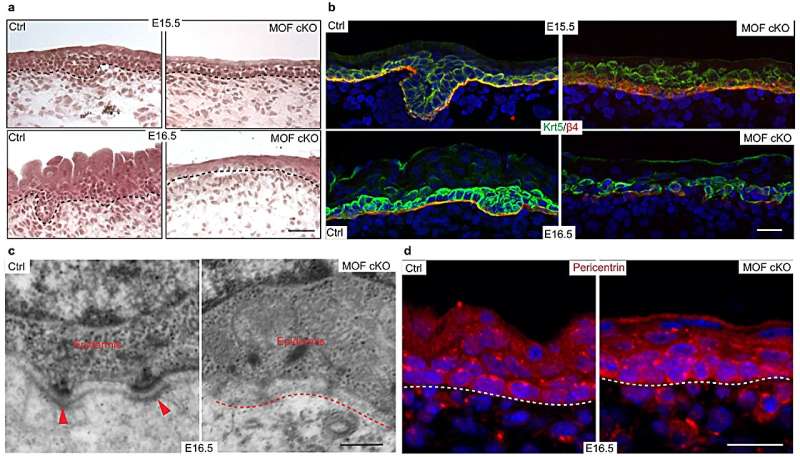This article has been reviewed according to Science X's editorial process and policies. Editors have highlighted the following attributes while ensuring the content's credibility:
fact-checked
peer-reviewed publication
trusted source
proofread
Study reveals importance of gene MOF in skin development

Northwestern Medicine scientists have revealed how a gene considered essential for histone modification regulates skin development, according to a recent study published in Nature Communications.
While previous studies have suggested that the gene MOF is known to be involved in many mammalian processes related to histone modification and gene expression control, this study is the first to demonstrate the importance of the gene in skin development, said Rui Yi, Ph.D. the Paul E. Steiner Research Professor of Pathology and professor of Dermatology.
"For this particular study, we were interested in a mechanism called epigenetic regulation, which studies how the histone is modified and how that modification affects gene expression for skin development," Yi said.
In the study, investigators generated mice embryos with the MOF gene knocked-out in epithelial cells of the skin. With the gene knocked out, the mice embryos' skin could not develop normally, and the mice died shortly after birth, according to the study.
When taking a closer look at the cells utilizing single-cell RNA sequencing, investigators found that mitochondria and primary cilia—two organelles necessary for healthy cellular function—both had malformations from the missing MOF gene which led to severe defects in skin development.
"What we found was without this gene, which is a histone modification enzyme, that the skin cannot attach properly, and falls off very easily, causing the mice to lose the protective layer," Yi said. "Secondly, the hair follicles cannot form. When looking deeper, it turns out that mitochondrial function and the primary cilia function are compromised. We think the significantly compromised function of the two essential organelles contributes to the defects we observed in skin development."
The findings add to the field's understanding of the genes that regulate mammalian skin development, Yi said, but could also be useful in understanding how skin cells age, which may be related to their mitochondria function.
"Mitochondria function particularly is important for the aging process," Yi said. "By studying this gene during skin development, we hope to gain some insight to inform us what might be happening when the skin or hair follicle becomes older and mitochondria function becomes defective and whether this gene and the regulated targets play a role in those processes."
MOF also appeared to regulate the expression of other genes, according to the study, and more work is needed to better understand how this is achieved, Yi said.
"In the future, we'd like to understand how this gene regulates the expression of other genes that are not involved in mitochondrial or primary cilia function," Yi said. "The second aspect we're interested in involves aging research. For example, can we remove this gene in older skin to see whether this gene could accelerate the aging process? And can we reverse that process by enhancing the function of this gene?"
More information: Dongmei Wang et al, MOF-mediated histone H4 Lysine 16 acetylation governs mitochondrial and ciliary functions by controlling gene promoters, Nature Communications (2023). DOI: 10.1038/s41467-023-40108-0
















